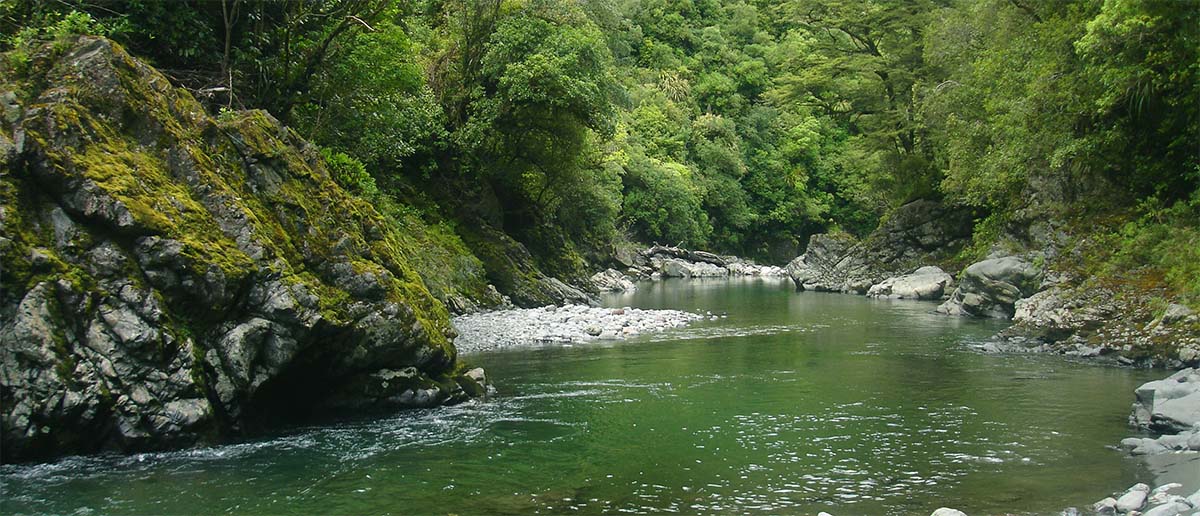Fishing the Bush Stream Cicada Season
I’m passionate about all forms of fly fishing, yet there’s little to equal the visual beauty and intensity of fishing big terrestrial imations to large fish in crystal clear New Zealand backcountry streams.
Brown trout in bush streams are spooky when the season opens in October and become increasingly wily as it progresses. Around the beginning of February when trout are close to infuriating, cicadas hit the water and all of Messers Brown’s disdainful resolve and superior breeding vanishes.
Previously recalcitrant trout enthusiastically cover unusually large distances, vertically or horizontally, to seize juicy cicadas. This is also when trout are in their best condition and sea-runs move into headwater streams for the spawning season.
Matching the Hatch
The cicada responsible for the seasonal ‘hatch’ in the native bush is the ‘chorus cicada’, Amphipsalta zealandica, which happens to be the largest and noisiest of more than 30 species of cicada in New Zealand. Males do the ‘singing’ via specialised chambers in the abdomen called tymbals, and females make clicking sounds using their wings.
Two other species, much smaller than the chorus cicada, and commonly found on bush streams are the ‘greater bronze cicada’, Kikihia cauta, and the ‘lesser bronze cicada’, Kikihia scutellaris, which have a softer song and are known collectively as shade singers.
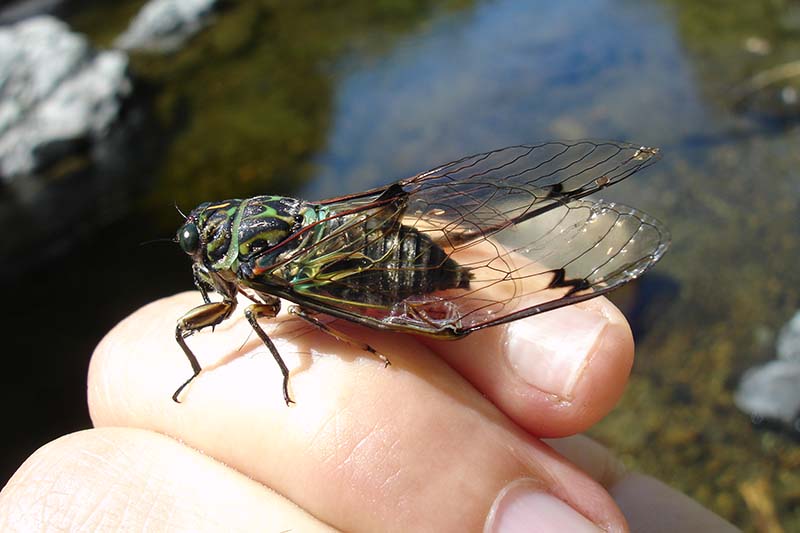
Chorus Cicada
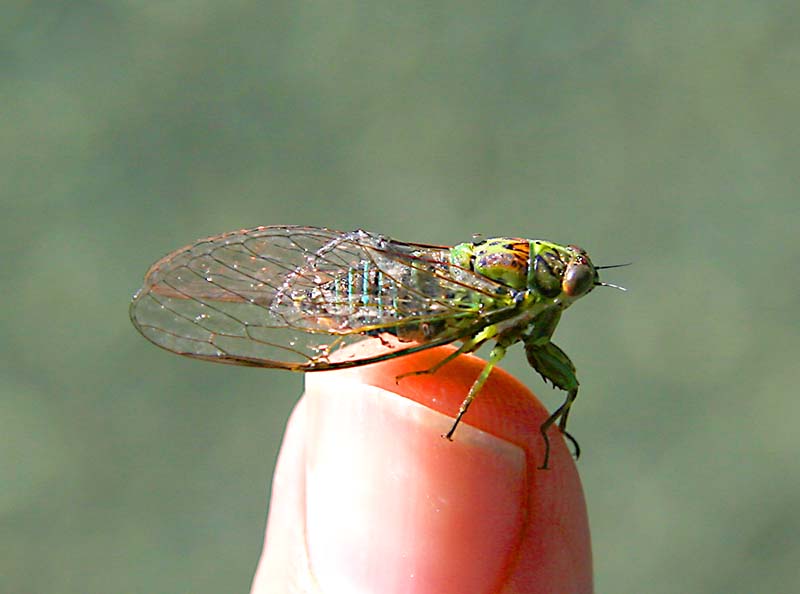
Lesser Bronze Cicada - shade singer
The long wings of chorus cicadas and shade singers are a key feature of the footprint of the floating naturals, an observation inspiring me to create the Silicone Wing Cicada fly (SWC). Links to the development of and tying instructions for this highly effective Cicada fly pattern are at the end of this article.
Amphipsalta cicadas first make an appearance around the coast in early December, but it’s generally not until late January or early February that the hatch has developed sufficiently in backcountry valleys to attract the attention of trout living there. Trout have to learn each season that these super-bugs are food, and won’t show any interest in imitations until they are onto the naturals.
On several occasions I tried fishing my SWC in mid summer just before cicadas were abundant - one or two fish took a casual look but I didn’t elicit a single take. A few weeks later when the valleys were filled with the chorus of amorous Romeos, big brownies were charging the SWC from all directions. Fortunately trout retain the cicada search image for at least two weeks after the naturals have disappeared, providing anglers with an extended cicada fishing season.
In late summer, February and March in New Zealand, I usually use a size 8 SWC as chorus cicadas are typically the most abundant species on bush streams and larger prey patterns have more pulling power. I’ve nevertheless done very well with a size 12 version when there have been a lot of shade singers about and/or the chorus cicada hatch has been relatively weak, slow to start or has ended early.
Gear
My days in the hills are usually chosen to coincide with lower water flows and sunny weather for sighting fish. In these conditions I like a fast action 5 wt rod with enough feel to make accurate casts in-close to fish, but with sufficient backbone to go long when prospecting large deep pools and putting breaks on strong backcountry fish, e.g. a Douglas Sky G. On windy days a 5wt rod with a bit more power is an advantage, e.g. a Hardy Zenith.
Choice of fly line is critical as presentation tapers will struggle to turn over large wind-resistant cicadas patterns, especially when a tungsten nymph is attached.
A fly line that works especially well for me on backcountry rivers is Scientific Angler's Amplitude MPX. It shoots like crazy and has a great balance between grunt and presentation for casting large dry flies on long leaders, even with a nymph attached. With the line’s reversed taper it also loads the rod well for short accurate casts that are often necessary.
My standard leader for cicada fishing is 15 foot long and ends with a few feet of 4X Fluorocarbon tippet. A clunky loop-to-loop connection sticks in the guides when trying to get the fly line out of the rod tip upon spotting a fish and when fighting large trout, resulting in missed opportunities and break-offs.
I therefore like to attach the leader to the loop on the fly line with a clinch knot, or better still, remove the welded loop and attach with a snell knot for an even smoother connection. For more on attaching long leaders to fly lines, see my Scientific Angler's Absolute Trout Presentation Leader review I provide a link to at the end of this article.
The best backcountry leader I’ve used in the last two decades is a 3X 14 ft Scientific Anglers Absolute Trout presentation leader. The butt sections on these leaders are thicker than average and very supple, providing the mass to turn over large wind resistant dry flies and heavy nymphs, even into a breeze. I usually trim back around two feet of the 3X tippet section, tie on a tippet ring, then add 3 feet of 4X fluorocarbon tippet, which produces a 15 ft leader.
Scientific Anglers Trout Supreme fluorocarbon is supple and thin for its breaking strain, it knots well and is extremely tough and durable. Fluorocarbon is not all made equal, and some brands tend to weaken with use and also pop at the knots when striking with dry flies. For this reason some anglers prefer 5 or 6 lb Maxima Chameleon, which is nylon. But I find Trout Supreme fluorocarbon to be tougher and more durable.
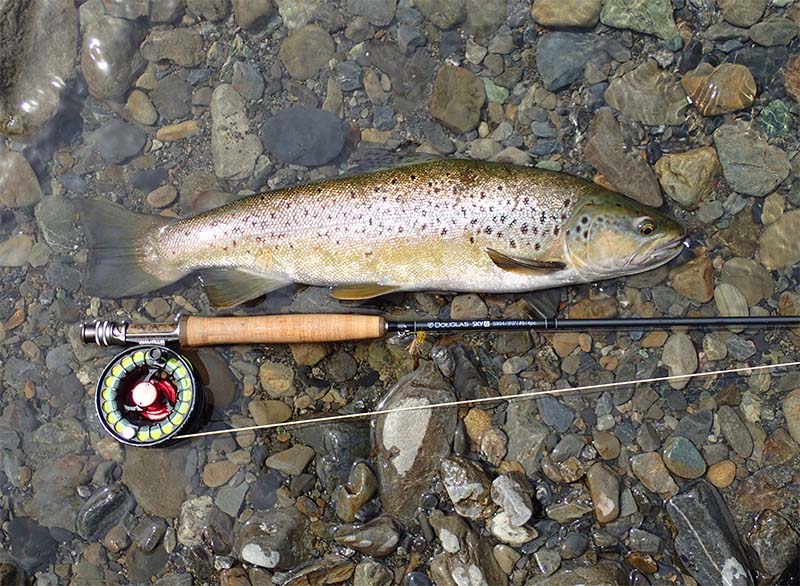
Fishing Strategy
A standard approach to fishing backcountry streams is to only cast to sighted fish. This is a sound strategy when nymphing or fishing small dries because you usually need to position your fly within a foot of the fish before it responds - and there are not a lot of fish around.
Cicada fishing is different.
Unseen trout lying hidden amongst the boulders, 4 or even 10 feet below the surface, will happily fin all the way to the top to engulf a juicy cicada. Scientific research shows that expert anglers spot only a third of the available trout on backcountry streams, so accessing the other two-thirds of fish through careful prospecting will boost catch rates.
Trout in deep clear water have large surface windows. This is an advantage for the angler because the fish see cicadas a long way off and each cast effectively covers a big area; on the other hand it’s a disadvantage as this increases the risk of trout spotting the angler or the fly line or witnessing drag. So, casts need to be planned carefully.
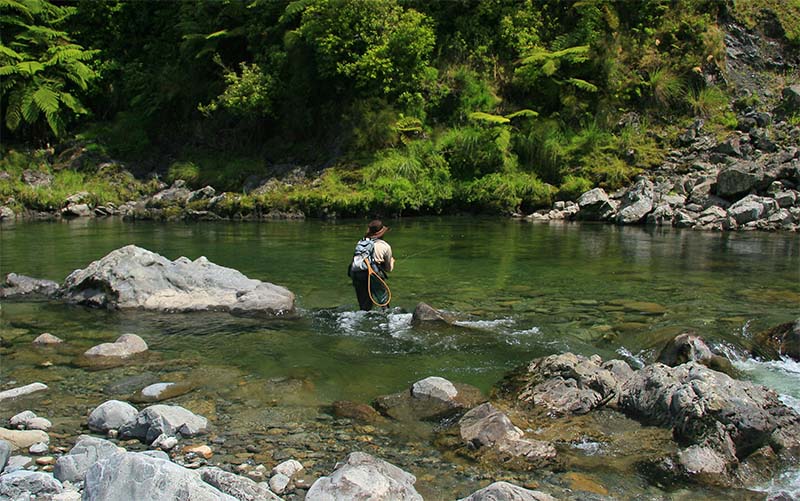
Approaching the water
When I approach a good piece of water, from a concealed position I spend time looking for fish and studying current patterns because I know I can draw fish up with a good presentation.
If I don’t see any fish but am not certain there are none, I make a short cast of about 18 or 20 feet (2 to 4 feet of fly line and the rest is leader), straight up the current lane. This way there’s little chance of drag as the line and leader are not lying across currents of different speeds.
The next cast is also directly upstream but just inside the seam. I then incrementally lengthen the cast by 5 to 10 feet and repeat the two-cast process until all fish-potential water has been covered, or I need a new casting position to tackle a different feature, e.g. the head of a pool. I find that fish usually rise on the first or second cast, so more than that is a waste of time.
There are situations where the upstream approach is either not possible or requires some adjustment:
The first is pockets, runs or pools where the water speeds up over the lip, sucking on the fly line and causing the fly to drag. Here you have to either use high sticking techniques to cover the tail before wading upstream and past the problem area, or tackle the area with short up-and-across casts from the side. You will need to keep low and move slowly with the up-and-across approach, to ensure fish don’t see you.
Another situation where the upstream approach is not suitable is when covering back eddies common in upper portions of large bush-stream pools. These often hold good fish and a successful approach for me has been to make a slack-line cast, then feed line onto the water by flicking my rod tip as the fly drifts away. Longer casts and keeping low are often required because trout are usually facing the angler.
When I spot a fish, the most important factor determining casting position and angle is current pattern. Ensuring my cast does not cross currents of different speeds eliminates the dreaded fish-spooking drag. Depending on the lie, I may need to wade out and position myself directly downstream of the fish, while in other situations an up-and-across cast works best.
I try to drop the fly a few feet ahead and to the shoreward side of the fish, so the leader angles away and is on the other side of the fly when the fish approaches. Depending on the casting angle, up-and-across casts that have the fly drifting directly onto the fish also work well. Plopping a cicada on top of a trout’s head in shallow water may very well spook it.
Pacing yourself
Trout on backcountry streams are usually sparse with patchy distribution. If you fish too slowly you may waste time on unproductive water, but if you move too quickly you will miss or spook fish.
I tend to start slow then speed up once I have a feel for the amount of fish and where they are holding. Some days, trout are mostly in the eyes of pools while on others they sit mostly in the tails. There are also days when pockets of water can be more productive than pools.
Timing the Strike
Even when rivers are low and clear I see only half the fish I catch before I cast, although I usually do see them approaching the fly.
The speed with which a trout approaches and takes the fly varies from an excited dash to ever so slow and deliberate.
Watching a big fish home-in on a dry fly is highly exciting but adrenalin can wreak havoc with your connection rate. It’s best to watch the fish and get used to striking once its mouth has closed and the head is facing downwards or the fish is moving away from you.
A deliberate lift of the rod usually works better than a quick nymphing-style jerk, which can snatch the fly from the fish’s mouth or result in a break-off.
Remember to keep recovering line while watching the fish swim toward the fly, otherwise you’ll fail to make contact on the strike.
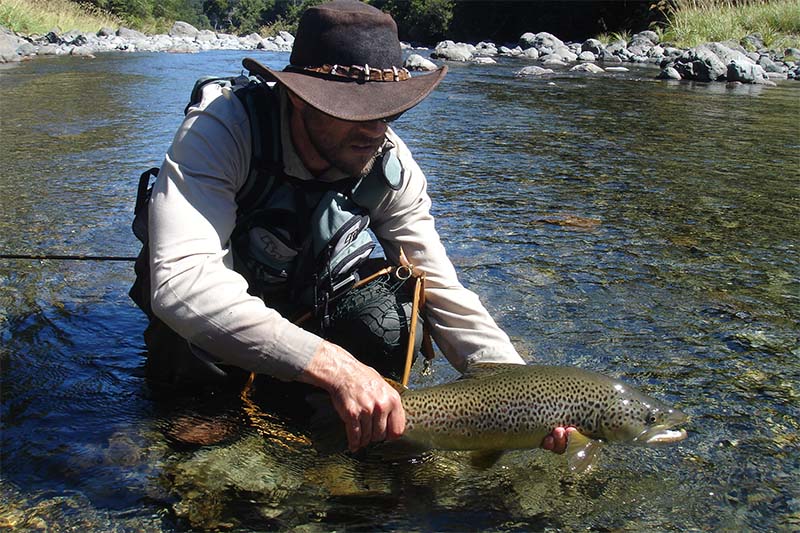
Difficult Fish
Most brown and rainbow trout on backcountry rivers go crazy for cicadas during the seasonal hatch, although some fish will cock-a-snoot at your offering. Either the fish are not yet onto cicadas or have had a bad experience with an artificial one.
If uninterested fish continue to feed, tying a nymph of appropriate weight to the hook bend of the cicada is often effective. But don’t waste too much time on these fish as there is invariably an eager cicada muncher around the corner.
I prefer not using a nymph permanently tied to the cicada fly, i.e. dry/dropper, as it affects the drift and I also miss a lot more fish when they take the large SWC. I suspect this is because the tippet protruding from both ends prevents the big fly entering the mouth of a four or five pound trout, which is less of an issue with smaller dry flies.
If fish on bush streams consistently mouth, slash or nip a size 8 SWC but do not eat it, I use a size 12 SWC. Using this smaller version has been especially helpful early in the season or when there are not many chorus cicadas about.
Difficult fish late in the season on pressured rivers usually means they have already been caught on cicada patterns. A good strategy for this scenario is to spend time prospecting less obvious holding water, like pockets and undercut banks where trout are difficult to spot and other anglers are less likely to have fished.
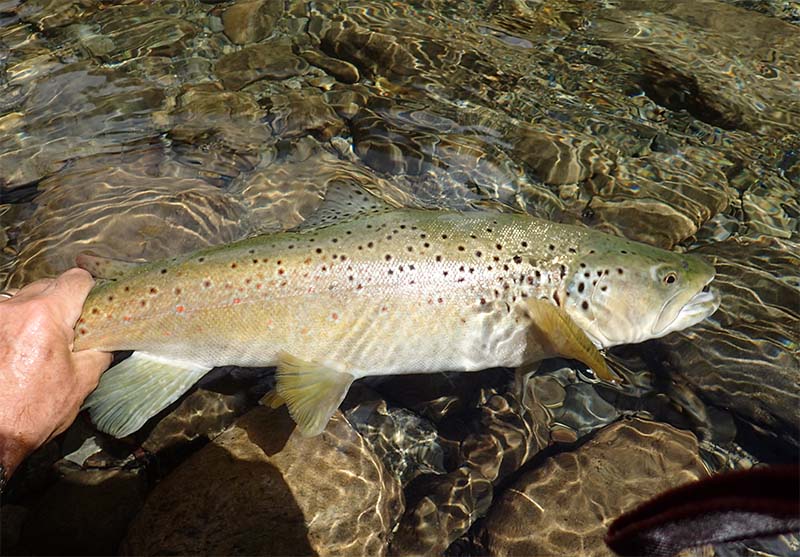
Also see :
+ |
Designing the Silicone Wing Cicada |
|---|---|
+ |
Tying the Silicone Wing Cicada |
+ |
Scientific Angler's Absolute Trout Presentation Leader Review |
